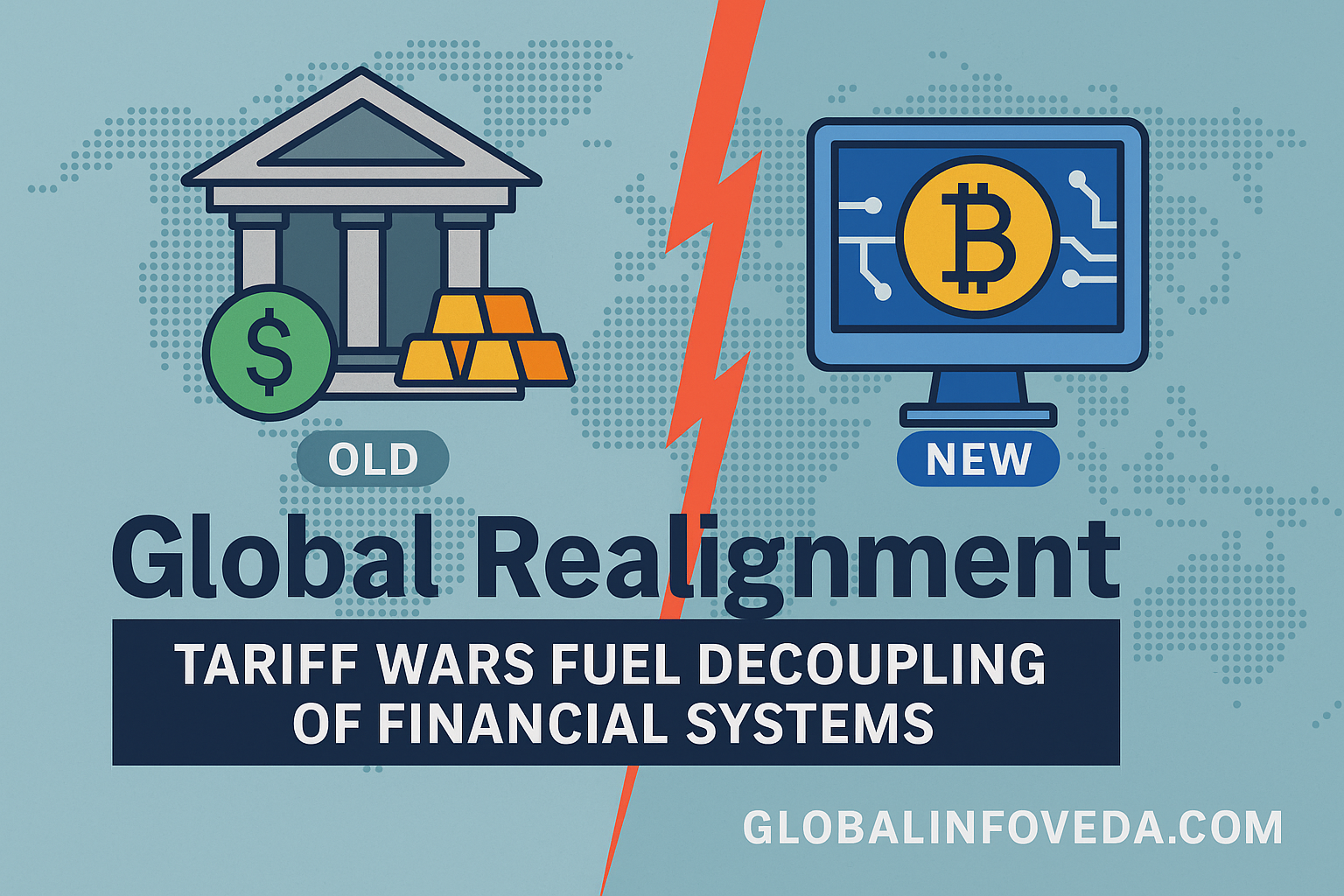Global Realignment: Tariff Wars Fuel Decoupling of Financial Systems
🌍 Introduction: From Trade to Tender
The global economy in 2025 is facing a historic inflection point. What began as isolated trade disputes—like the U.S. raising tariffs on India, China, and other manufacturing powerhouses—has now snowballed into a full-blown financial decoupling movement. The modern battlefield isn’t just about goods and services. It’s now shifting to monetary systems, currency alliances, settlements, payment sovereignty, and the future of global financial governance.
For decades, the world operated under a dollar-dominated system centered on SWIFT, IMF policies, U.S. Treasury bonds, and Wall Street-driven capital flows. But in the wake of increasing trade weaponization, countries are seeking resilience, autonomy, and pluralism—birthing an era of monetary multipolarity.
The question is no longer whether this transition is occurring—but how fast and how deeply it will penetrate global finance.
🌐 Forces Accelerating the Financial Decoupling
1. Weaponization of Trade & Financial Instruments
- U.S. tariffs and secondary sanctions are increasingly used to coerce political compliance.
- Countries fear being locked out of global payment rails, similar to Russia’s post-Ukraine experience.
- Central banks are responding with gold accumulation, non-dollar FX reserves, and greater use of bilateral trade agreements.
- Rating agencies and financial indices are now viewed with caution by emerging economies fearing bias.
2. Surge of Regional Currency Blocs
- INR-dirham, Yuan-ruble, Riyal-Lira, and ASEAN Pay are being institutionalized through MoUs and cross-border banking accords.
- Oil and gas trade, once exclusively dollar-denominated, is now increasingly transacted in Yuan, Rupee, and Dirham.
- In 2025, BRICS currency corridors account for $670 billion in annual trade.
3. Adoption of CBDCs and Digital Rails
- Over 30 countries now have active or pilot-stage CBDCs.
- India’s e₹ is tested for cross-border smart contract payments.
- Programmable CBDCs allow selective subsidies, geo-fencing, and automated taxation.
- Interoperability between e₹ and e-CNY is under pilot via blockchain nodes based in Singapore.
4. Rise of Interoperable SWIFT Alternatives
- BRICS Pay, SPFS, and CIPS allow members to avoid sanctions, delays, and surveillance concerns.
- India’s SFMS is now expanding to cover remittance corridors in the Gulf, Africa, and SAARC.
- A “Digital Banknote Exchange Network” is proposed under BRICS+ to swap CBDCs directly, bypassing forex intermediaries.
🏦 How Global Financial Architecture Is Shifting
| Old Model (Pre-2020) | Emerging Model (2025 Onwards) |
|---|---|
| Dollar reserves held by all | Mixed reserves: Gold, Yuan, Euro, INR, digital assets |
| SWIFT for all settlement | Parallel rails: CIPS, BRICS Pay, SFMS |
| U.S. T-bonds as safe haven | Diversified: Rupee-bonds, sukuk, green bonds |
| FX hedging with USD instruments | Local currency pairings and barter settlements |
| IMF-dominated lending | Bilateral funds, BRICS Bank, Asia Infrastructure Bank |
| Wall Street capital flow dominance | Decentralized liquidity via tokenized bonds & DeFi |
🇮🇳 India’s Strategic Position in a Fragmented Financial World
India is uniquely placed as a tech-forward, regulatory-capable, and geopolitically balanced nation. As Western and Eastern systems compete, India adopts a bridge-building strategy:
- e₹ Pilots: Conducted with UAE, Mauritius, Bhutan, Singapore, and Sri Lanka for use in remittance, trade invoicing, and fintech interoperability.
- Multi-currency trade desks created in Mumbai and GIFT City to support direct settlement in rupee, dirham, yen, and ruble.
- RBI’s Forex Strategy Unit evaluates capital controls, sovereign FX buffers, and stablecoin integration.
- Unified Payment Interface (UPI) Global Framework is under negotiation with ASEAN and Gulf partners.
- Digital Trade Corridors launched with Bangladesh and East Africa using blockchain-based smart contracts for customs and logistics.
- Backing a “Global South Sovereign Ledger” to settle trade via tokenized currency baskets using distributed ledger technology (DLT).
📉 Risks and Trade-offs in a Multipolar Monetary Order
Despite its benefits, the decoupling is not without complexity:
- Fragmentation Risk: Competing standards create silos in global payments.
- Loss of Scale Efficiencies: Dollar-centric systems had high liquidity and low slippage.
- Currency Volatility & Dual FX Exposure: Firms operating in more than two jurisdictions face higher hedging costs.
- Legal Ambiguity: CBDCs and digital trade protocols lack uniform regulations.
- Security Concerns: Increased risk of cyberattacks on fragmented and decentralized systems.
- Investment Caution: Portfolio investors face reporting mismatches and differing tax treatments across digital and physical trade zones.
However, the urge for strategic monetary sovereignty outweighs these risks—particularly for emerging economies.
🧭 Final Insight: From Dollar Dependence to Currency Coalitions
The world’s financial landscape is entering a period of foundational redesign. Tariff wars acted as a catalyst—but the deeper transformation is one of sovereignty, interoperability, and localized economic security.
Looking ahead:
- Expect coexistence of 3–5 dominant payment blocs (U.S.-led, China-led, India-anchored, Eurozone-linked, Digital South).
- Rise of AI-managed, blockchain-auditable smart payment rails.
- Regulatory bodies will need to craft digital Bretton-Woods-style conventions.
India’s approach—measured, inclusive, and innovation-driven—positions it as a co-architect of a plural financial world order.
📡 Stay tuned to GlobalInfoVeda.com for weekly reports on how India is building fiscal resilience in an age of disruption.
